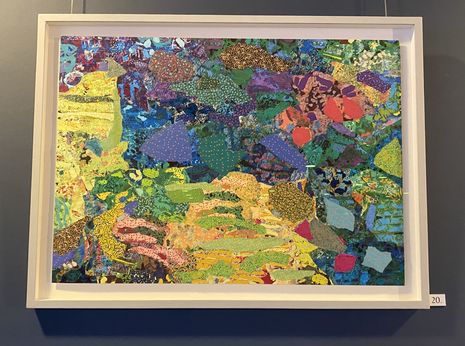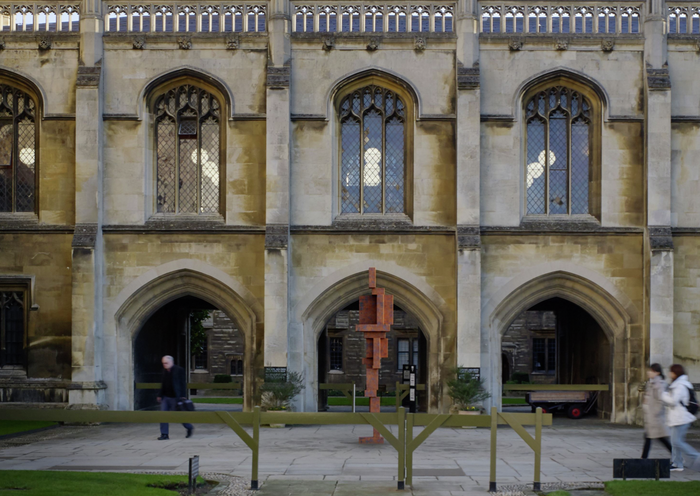Clare Hall’s latest exhibition is ‘A Feast for the Eye’
‘Living in a time where everything is so readily force-fed to us through a screen, I found the still, spiritual quality of this exhibit particularly therapeutic’

Held in Clare Hall, I was pleasantly surprised by ‘A Feast for the Eye’: an exhibition of paintings and collages by Jerry Scott. Although nowhere near as impressive as other more large-scale Cambridge exhibitions that are on right now, such as ‘Defaced!’ at the Fitzwilliam Museum, abstract art lovers in particular will find much to enjoy.
Initially going into the exhibit, I (so observantly) immediately noticed the two distinct art styles: the paintings and the collages. Yet, the deeper I went inside, the more I began to decipher the joyfully subtle differences that existed within these categories. I found myself discovering three, four, and five different types of styles, enjoying the process of breaking up these collages into unique sects. Whereas some collages consisted of large chunks of colour - blues, greens, and purples blending into each other with lumps of orange and red creating bold contrasts – other collages were much wilder. The individual pieces in these collages had more variation in size; were smaller; and were less cleanly cut. Their textures and shapes were also less immediately obvious. The mismatched wilderness of this work represented a freer and less tamed art form than the other pieces in the exhibit.
The joy of this display lies in the arts’ ability to reveal something new to you every time you look at it
I found myself searching for familiar shapes amongst the chaos, envisioning a panda; a monkey; or a human form. These forms all unintentionally evolved from the mess of shapes in the collages. This process of pattern-making was particularly therapeutic and even more so as I began noticing and looking out for repetitions of the same materials that were used in different pieces. I also found myself intrigued by how the collages were built, whether the art was pre-planned or just appeared out of the moment.
I wasn’t as immediately intrigued by Scott's paintings. Some of the paintings closely mimicked the style of collages, composed of somewhat uniform squares in rather dull tones. In the same vein, I wasn’t as immediately impressed with his other abstract work that unoriginally reminded me of pieces I’d seen a hundred times before. However, the painting I found myself most drawn to was probably the most hidden of the exhibit. I found it tucked at the end of a corridor, hidden away in shadow. One of Jerry Scott's old friends also told me it was her personal favourite. She described it, and much of his other work, as having a spiritual quality. I found myself agreeing with this sentiment. The “most mysterious painting of the exhibit” was truly A Feast for the Eye.
Even though I’ve spent many an hour wandering around the Tate Modern in my time, I’ve always struggled to truly “get” or understand the point of abstract art. It's something as Arts editor that I’m not sure I should be admitting. But the questions I found myself forming while looking at the work in this exhibit helped me rediscover art as a creative and intellectual stimulant that it is for so many. Once I’d reached the end of the exhibition’s first corridor, instead of walking swiftly past the art I’d already seen, I found myself looking at all the pieces I had just passed again, with potentially even more interest this second time around. Each time I looked, I saw something new in them— discovering new patterns and pondering new questions inspired by the other artworks I’d seen.
It forced me to question what was in front of me rather than numbly scroll past it
Living in a time where everything is so readily force-fed to us through a screen, I found the still, spiritual quality of the exhibit forced me to question what was in front of me rather than numbly scroll past it. The exhibition had the special effect of taking me out of my own head for a moment and distracting me with the questions the art in front of me posed. Although I often find abstract art frustrating in the endless interpretations it can provide, this exhibit’s title reminded me that not everything needs to be a case of question and answer. Art can simply be a ‘feast for the eye’ – a sensory visual experience that allows you to focus your attention on your surroundings instead of your next load of supervision work.
When I returned home and began flipping through the brochure I was given, I finally discovered the names of the artworks which were unfortunately not displayed in the gallery itself. Even after leaving the exhibit, I found more questions developing. Did the names and intentions exist before the work, or did they stem from whatever Scott saw in his creation? A thought-provoking and therapeutic exhibition, the joy of this display lies in the arts’ ability to reveal something new every time you look at it.
 Comment / Plastic pubs: the problem with Cambridge alehouses 5 January 2026
Comment / Plastic pubs: the problem with Cambridge alehouses 5 January 2026 News / SU stops offering student discounts8 January 2026
News / SU stops offering student discounts8 January 2026 Theatre / Camdram publicity needs aquickcamfab11 January 2026
Theatre / Camdram publicity needs aquickcamfab11 January 2026 News / Cambridge academic condemns US operation against Maduro as ‘clearly internationally unlawful’10 January 2026
News / Cambridge academic condemns US operation against Maduro as ‘clearly internationally unlawful’10 January 2026 Comment / What happened to men at Cambridge?31 December 2025
Comment / What happened to men at Cambridge?31 December 2025









